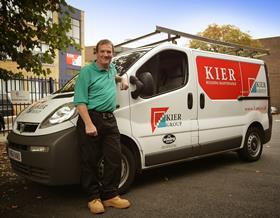Exclusive: Contractor confirms £12m restructure in construction business led to closure of four offices and 200 redundancies

Kier has shed 200 jobs and closed four regional offices as part of the restructure of its construction business, Building can reveal.
Kier confirmed that the restructure of its construction business, which incurred £12m of costs, involved the closure of four of its 28 regional construction offices, with the closures in Euston, Bromley, Edinburgh and Wisbech.
But the firm opened one new office in Waterbeach, Cambridge, which is now serving as the headquarters of its East England operations.
The firm said the office closures had led to “just over” 200 redundancies.
The confirmation of the redundancies and office closures came as Kier published its results for the year to 30 June 2013.
The firm said the £12m cost of the restructure included £10.1m incurred through “office closures and associated staff reductions”, with the remaining £1.9m related to the closure of its scaffolding, joinery and temporary electrical business.
Kier said the restructure was aimed at improving the efficiency of the business and maintaining its operating margin at above 2%. The firm said the staff reductions meant it had shaved 8% off its staff costs.

Speaking to Building following the publication of the results, Kier chief executive Paul Sheffield said the restructure of the construction business was now mostly complete, with the firm retaining its presence across its eight regions of operation.
“We’re pretty much there. It’s very much a question of making ourselves a bit more efficient and tightening our belt in some areas, and we’ve maintained our geographic presence, we’re just that bit leaner,” he said.
Sheffield said the business was now well positioned for growth, with the firm 10-15% ahead of where it would normally be at this point in the current financial year in terms of work secured.
He said he expected the construction business to post revenue of around £1.4bn in the current financial year, up 8% on the £1.3bn it reported for 2012-13.
Although building work has declined to just under £1bn of the construction revenue, he said this had now “bottomed out” and was expected to pick up again, with the firm anticipating growth in care homes, student accommodation, medium-rise affordable housing, as well as the commercial sector.
“There’s a bit of a return in the market on the commercial side, which has been very, very, flat for a few years. Four years ago 25% of our work was commercial, but today its a fraction of that. But there seems to be some confidence returning, with people prepared to take on new leases and extend their premises.”
He said he also expected growth in overseas and infrastructure work, particularly with large water and Network Rail frameworks being renewed and work in the power sector beginning to come through the pipeline.
He said: “Everything we can see in the pipeline is looking is more encouraging that it has been in a long time.We are taking a bit more of the market share as the group matures, but I also think that the long-awaited growth in infrastructure spending is now beginning to come through.”
The firm’s share of public sector work remained firm at 49% of construction revenue and Sheffield said he expected this to remain the case over the medium term.“Three years ago it was a 75:25 public-private split and I expected that to reverse, but now it’s about 50:50. The reality is the private sector has not been able to replace the public sector and that’s why the overall volumes have slipped back, due to the scarcity of work. I expect it to remain quite static for the next few years,” he said.
He said a further 6-8 offices were set to close across the business as part of the May Gurney acquisition, with a further 200 jobs likely to go. “That’s pure integration of the businesses. There was inevitably going to be some overall reduction and that’s pretty firm. But we’re coming to the end of that now. The real signal is that its growth from here,” he said.
He said the integration of May Gurney, which was acquired in July, was proceeding well, with most of the activity in joining the two businesses to be completed in the current financial year, though the full synergies of the acquisition would not be realised for 18 months. “It will be another year before you get the benefits of the savings to come through,” he said.
He said the acquistion of May Gurney had not seen the firm lose any contracts, and that it had enabled the combined group to bid on new projects worth more than £500m in water, rail and highways.
He said the May Gurney brand was now being phased out, though it would be retained for a period in some areas. “In principle we are changing [the brand] to Kier, but there are some activities that May Gurney did that Kier wasn’t particularly strong in and for some customers it’s quite important to keep May Gurney as a brand.
“It will phase out in time. But pretty much it changed the day we did the acquisition.”
In its results the firm reported group revenue, including share of joint ventures, of £1.98bn, down slightly from £2bn last year, with pre-tax profit, after £20.4m in exceptional items and finance costs, of £43m, down 32% on £63m last year.
The firm said the fall in revenue was primarily due to poor weather in the first quarter of this year, which caused delays to construction jobs, pushing revenue into the 2014 financial year.
The firm’s construction business posted revenue of £1.31bn, including share of joint ventures, down slightly on £1.38bn last year, with an operating profit, before exceptional items, of £30.4m, down 14% from £35.2m last year. This gave the business an operating margin of 2.3%.
The firm’s construction order book remained firm at £2.23bn, up slightly on £2.2bn last year.
“Bearing in mind we are at the end of a five-year recession, it’s a great set of figures,” Sheffield said.
“We can’t rewrite history, we are trading off the back of work that has been picked up in very difficult times and to come in with a profit margin just over 2% is a great place to be.”



























1 Readers' comment